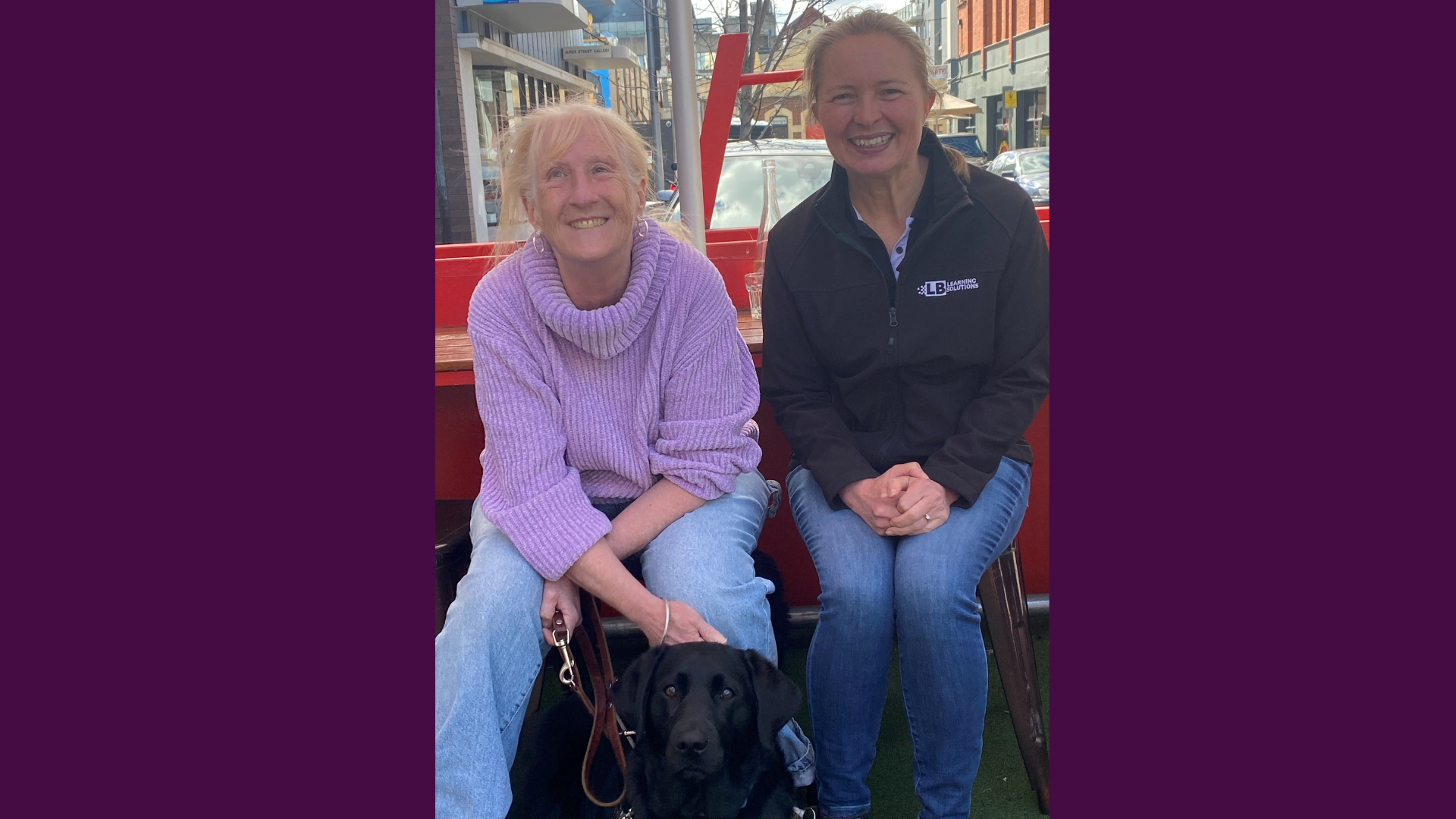The unexpected and incredible lessons I learned from babysitting my friend’s guide dog.
When my friend, Dr Dianne Ashworth, asked me if I would babysit her guide dog for a weekend my immediate answer was, “Hell, YES!”. I accepted in a heartbeat.
Who are Di and Gillian?
Di and her guide dog Gillian are a powerhouse of a team. Di is a former university lecturer, currently freelancing in social work and accessibility advocacy. And Gillian (Gill) is her guide dog. Gill is a perfect combination of smart and cheeky. She knows when to switch between work and play and takes both roles very seriously. What a thrill it was to be asked to babysit Gill. At least that’s what I thought until the enormity of the responsibility started to dawn on me.
Gillian’s everyday job
Gill is a working dog. She was socialised and trained over many months. For the first 12 months she lived with a Puppy Raising family and then returned to Guide Dogs Victoria for her official training. She was finally matched with Di, and they, as a team, graduated. It is expensive to train a guide dog, but Gill is worth every cent. And she takes her job very seriously. Gill protects Di’s life when she is out and about navigating the world. Gill is a communicator. Gill doesn’t speak, but she guides. The role Gill plays enables Di so much more freedom and independence than any stick can (Di never bonded with her cane!). Gill is a worker. But let’s not forget, Gill is also Di’s loving and much-loved companion. They spend every day and night together. This babysitting role was one I took very seriously.
Lesson 1: Detraining risks
“You can’t really muck it up in 2 days.”
But if Gill didn’t have consistency she could stop using her skills over time.
Before the babysitting had begun, there was the first lesson. Dogs need to apply what they learn just like humans do. As with humans, if dogs don’t apply what they have learned they begin to forget and abandon those learnings. If I was to take Gill walking without a harness, navigate my own way across every road without following her lead, constantly pat and distract her from her duties and treat her like a pet, she would adapt to that. My husband Dan and I were only looking after Gill for 3 days and 2 nights, but we didn’t want to contribute in any way to her potential detraining.
On-the-job study
Our first undertaking was to go for a walk to study Di and Gill in action. Here were our walking instructions:
- Gill always walks on the left
- Gill walks slightly ahead with tension on the harness / lead
- Gill walks briskly, with purpose
- Gill will walk in front of you if you don’t respond to danger (you must stop)
- Gill pauses and looks at every intersection waiting for Di to give her the command to “go forward”
- Gill responds to commands such as “left”, “right”, “wait”, “go back”, “walk”, and much more when she is working with Di
However, while we were minding Gill, Di said to walk Gill on my left side and not instruct her, because it might confuse her. No words, only consistent actions.
Our other instruction was to make sure we didn’t feed Gill too many treats. Labradors are notorious food lovers. Measuring out meals and treats is imperative, so she maintains a healthy weight.
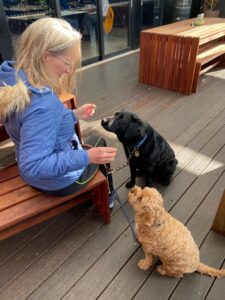
Lesson 2: Consistency and repetition
When it comes to walking, consistency is important. To make it easier for us, I nominated myself to be Gill’s walker, and Dan offered to walk with Hubert behind Gill and me. Some of you may already be familiar with our Cavoodle, Hubert. We figured we would walk both dogs at the same time. It couldn’t be too difficult, could it? I would concentrate on continuing Gill’s practices with her, and our spoilt little munchkin (Hubert) could continue in his own blissful world of sniffing and stopping whenever he liked.
For Gill it was a breeze. For me, it was a non-stop brain drain. It was a different way of dog walking.
A way of walking
Jealous Hubert kept trying to lurch forward to push in front of Gill and me. That was unexpected given his usual disinterest in hurrying. Plus, Dan had to keep shouting from behind “don’t forget to stop at intersections”, as I continually poised to take a step onto side roads without stopping, or realising I wasn’t stopping.
Purpose and determination
I was so impressed with Gill’s purpose and determination to lead the way. She even sensed my hesitancy and rose to the occasion. She is a professional whose skills have been honed through consistency and repetition over time. Me, on the other hand, could do with more practice.
Lesson 3: The poo lesson
Did you know guide dogs, poo straight into poo bags? I didn’t! What a great workaround that toilet harness is. There is a strap that fits around the dog’s belly. One handle of the poo bag attaches to the toilet harness underneath. The dog’s tail goes through the other handle and then is secured to the harness on top. Previously I hadn’t thought about trying to pick up poo from the ground if you couldn’t see it!
When Di was showing me what to do, she navigated the toilet harness so dexterously. But it still befuddled me. I had to be shown several times.
The secret word(s)
There is also a specific command to use that is not “poo” or “toilet” or “wee wees”. It is “quick quicks”. Could I remember all of this? I wasn’t sure. Thankfully, I didn’t have to use the toilet harness (or the quick quicks command) because I can see poo. On Di’s suggestion I decided to pick up poo the conventional way to make my job a bit easier. Whew!
Lesson 4: Always on the job
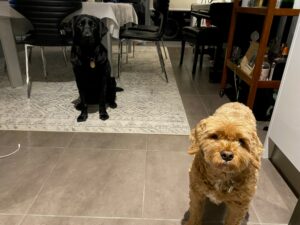
Gill knew she was on holidays. She was staying in a different house. Di wasn’t around. Dan, Hubert, and I were unfamiliar housemates. We were terribly clumsy walkers. Gill was on a regular lead with us. She sensed the freedom of it, and she enjoyed socialising with other dogs at the local coffee shop. But when we walked with purpose, it was different. Gill’s responsibilities never left her. She looked in every single driveway we passed to make sure no cars were reversing. She monitored movement on the footpath. And most impressively, she positioned her body in front of me when I was talking on the phone as I approached a traffic-lighted crossing.
Work ethic
Gill is always on the job of protecting her handler. Her work ethic is ingrained, and she takes her responsibility seriously. It’s a wonderful thing to witness.
Lesson 5: Assumptions about workers
With that in mind, we know a Guide Dog like Gill is working when she is wearing a harness. Some dogs may also wear a distinguishing vest. Without the harness (or vest) however, Gill is just as playful as any other Labrador. She is young and very excitable. She whizzed around our house and played games gleefully with the lead off. Gill is incredibly goofy.
Harness on = serious work
Harness off = down time
Interactions
Any time you see an assistance dog out in public, take note whether it is wearing a harness or vest. This will let you know whether they are working or not. With a harness or vest, even a dog sitting under a table at a venue may still be working. They might be at ease, but they are always at the ready. We can’t assume it is OK to pat or distract them in any way.
As it happens, it is generally good practice to check with any dog’s human before you interact with their dog even if they appear friendly. There could be many reasons why it is not OK to approach. In the case of an assistance dog, we demonstrate respect for their role by avoiding unnecessary distractions.
Lesson 6: Collaborative learning is for dogs too
Dogs teach others their expectations and personal boundaries. This is something I have always loved about dogs. They are great readers of body language. They are equally great at giving off body language to each other, and when communicating with body language fails, they become vocal or physical to get their message across.
Teaching and learning
Believe it or not, Hubert taught Gill some things. She learned quickly too. It only took a side-eye to stop Gill from playing near his bed. Also, at our house dogs don’t sleep on our bed at night so Hubert let out a low slow growl when Gill tried to jump on our bed. Gill got off straight away and didn’t attempt to jump up again. She slept in her own bed, next to ours.
And as for the things Hubert learned. I’m sure his mind was blown. Gill perked him up. Hubert started to walk perfectly in her presence. He strutted along and ignored the intoxicating scents along our street. He was a perfect angel of good behaviour!
So, with boundaries set we saw the real collaboration start. Gill and Hubert recognised a common interest – food. Both dogs worked together on us. Seamlessly they teamed up to manipulate us at dinner time. Can you see how hungry they are? They are positioned on either side of the bench for better visibility. Very clever.
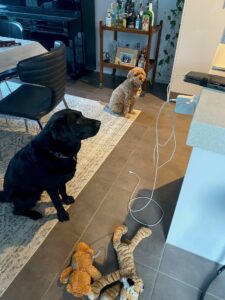
Lesson 7: The best type of safety message
Something I learned from Gill was most unexpected. Gill reminded me about road safety. Over time I have become lazy with road safety. I regularly walk around suburban streets near my house. I do it every day. I know which streets rarely have traffic, and how long it takes to wait for the traffic lights to change for the pedestrian crossing . . . I have become complacent about it. Sometimes I assume no cars are coming on quiet streets and don’t look, and I even ignore the red pedestrian light at times.
Lead by example
Gill would have none of that. As we approached intersections with traffic lights Gill gently guided me over to press the pedestrian button. She waited patiently for the light to change and checked first before setting foot on the road. What a wonderful reminder.
On one of our suburban rambles a car began reversing out of a driveway ahead of us. I saw it, but I kept up my pace with the intention of stopping just short of the car. Gill saw the car too. She sensed I hadn’t reacted, and her instincts kicked in. She manoeuvred her body in front of me, forcing me to come to a complete and immediate stop. What a girl! Even without her harness she stepped up to work and protect me.
Lesson 8: Everyone needs to take a break
When it was time for Gill to go home our feelings were mixed. We were sad to see her go. And thrilled at the same time to see Gill’s reaction when reunited with Di. That was our final lesson.
Take adequate breaks
We all benefit from taking a break. Both Di and Gill were happy to be back together, yet both had enjoyed having a short time apart. Dan, Hubert, and I had enjoyed the break in our routine too. It gave each one of us a spring in our steps. We were reminded of the things that matter and treated to some experiences that stretched our thinking.
When I look back on those few days, I am impressed at how much learning took place, and how much of what I reflected on is relevant for every learning experience. I have takeaways on all these topics:
- On-the-job analysis
- Application of learning
- Consistency and repetition over time
- Having a purpose
- Avoiding assumptions
- Seeking permission
- Collaboration
- The wider role of teaching and learning
- Taking adequate breaks
Inclusive learning and accessibility
Dr Dianne Ashworth regularly tests documents and eLearning for LB Learning Solutions using the screen reader, JAWS (Job Access With Speech). Di, Gill, and I also like to catch up for lunch (or a coffee) when we get the chance.
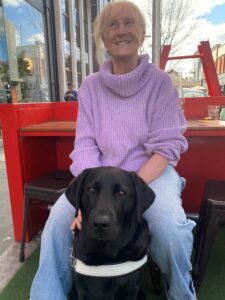
Contact us if you would like to discuss your interest in joining us some time.
Explore the different types of accessibility workshops and individual digital accessibility support options available on our website.
Book a free 15-minute discovery meeting (phone or zoom) with Lyndal to discuss your interest in inclusive and / or accessible learning.
Or for more general information about LB Learning Solutions visit our LinkedIn page, or our website home page.
